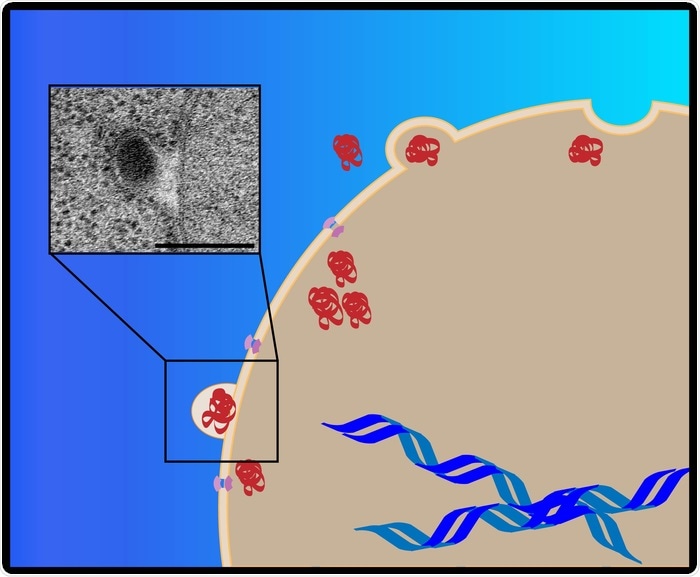A pathway for cell waste transport, which was undiscovered earlier, can be crucial for future treatments of cancer and dementia. In a new study, researchers have identified a new pathway that cells use to eliminate cellular waste that otherwise would damage the cell’s genes.

Human cell, animal cell. Medicine scientific, life and biology, molecular research DNA. Image Credit: Dimitra Panagaki.
The new transport pathway was found to pass through the membrane of the cell nucleus, which usually safeguards the DNA. As part of the research, the cells were stressed to increase the traffic of small envelopes of waste passing through the membrane of the cell nucleus. Thus, the researchers exhibit a pathway used to eliminate cellular waste that otherwise could damage the genome of cells.
“This insight in the cell’s normal function can be important for treatment of both cancer and dementia,” stated Johanna Höög, who led the study that was recently published in the highly ranked scientific journal PNAS.
Using high resolution electron microscopy, we could see how aggregates of proteins are sent in small envelops through the cell nucleus membrane. Together, we have described a previously unknown transport pathway in the cell’s waste management.”
Dimitra Panagaki, Study Co-Author and Doctoral Student, Department of Chemistry and Molecular Biology, University of Gothenburg
The cell constantly forms new proteins
New proteins continuously form within a cell, while other proteins are disintegrated into their constituent parts and recycled. This is crucial for the cell’s health because quite similar to the accumulation of waste in any environment, damaged proteins can turn toxic.
“This completely unexpected link between the transport through the cell nucleus membrane and the quality control of the cell’s proteins was what I thought was most interesting,” stated Jacob Croft, doctoral student at the University of Gothenburg and active in the project.
Common phenomenon in the cells of all studied species
The research also investigated the frequency at which the phenomenon of sending small envelopes through the cell nucleus membrane occurs. The team was able to demonstrate that it happened among all species analyzed, ranging from small single-cell parasites to human cells.
Upon stressing the cells in different ways, for example, by exposing them to high temperatures or toxic substances, more proteins folded improperly and there was an increase in the frequency of waste transport through the membrane of the cell nucleus.
“It is perhaps most important that the damaged proteins are separated from the genome, where they can cause mutations that in turn can cause more damaged proteins,” stated Johanna Höög.
The waste can kill the cell
Incorrect waste management in the cell can lead to a downward spiral where waste finally destroys the cell. At times, this happens in the brain with Alzheimer’s disease and in certain other forms of dementia.
On the other hand, cancer cells produce more waste than healthy cells. This is used by some chemotherapies that stop normal cell waste management to result in the faster death of the cancer cells than our normal cells, forcing the cancer into remission.”
Johanna Höög, Study Lead, University of Gothenburg
New cancer treatments possible
The waste management system of cells is already a focus of target for cancer treatments. Therefore, the researchers consider that the finding of an undiscovered transport pathway can open the door to new, more effective treatments for cancer.
Waste transport through the cell nucleus membrane increased upon treating the cells with a chemical that inhibits waste processing and is used for cancer treatments.
You could say that we sealed all the openings in the cell’s treatment plant, known as proteasomes. This caused the cell to compensate and remove the incorrectly folded proteins through this transport pathway instead. We now hope to receive more research funding to study the molecular mechanisms behind this cellular waste transport and look more closely at the phenomenon in cancer cells.”
Johanna Höög, Study Lead, University of Gothenburg
Source:
Journal reference:
Panagaki, D., et al. (2021) Nuclear envelope budding is a response to cellular stress. Proceedings of the National Academy of Sciences. doi.org/10.1073/pnas.2020997118.